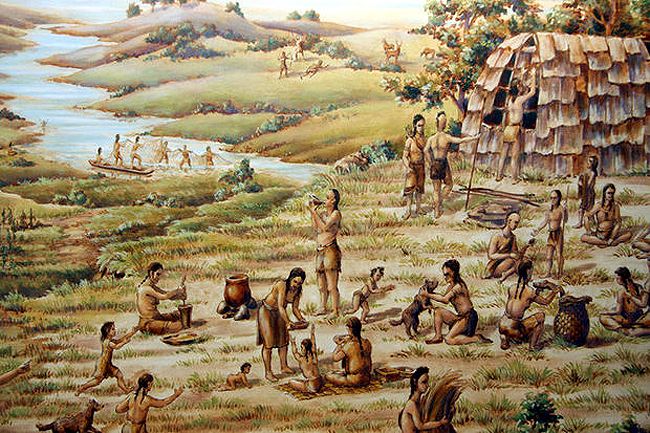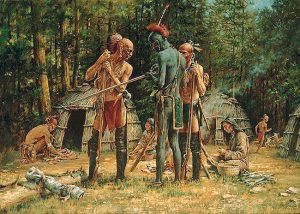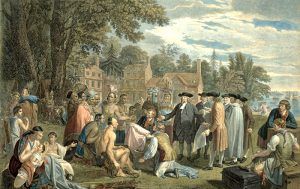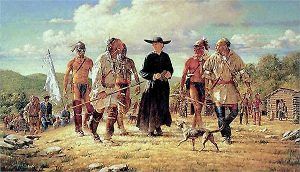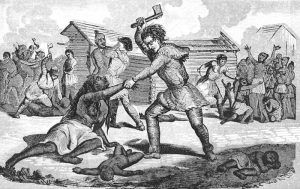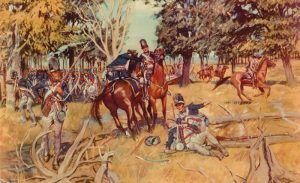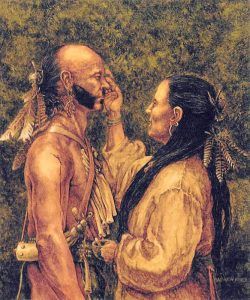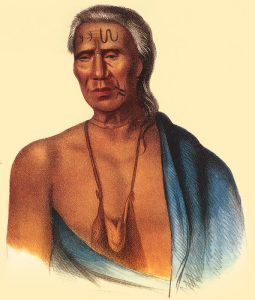The Lenape or Delaware tribe, also called the Lenni Lenape, are of the Algonquin family and first lived in New Jersey, Pennsylvania, and New York. Traditionally they were divided into the Munsee, Unami, and Unalachtigo, three social divisions determined by language and location.
The Lenape claimed to be the “parent” from which numerous Algonquin tribes descended. Their name Lenni means “genuine, pure, real, original,” and Lenape means “Indian.” Their claim to superiority was recognized by the other tribes, who accorded them the title of “Grandfather.” The tribe’s common name of Delaware is not of Native American origin, but the English colonists called them that for the Delaware River
The Lenape had a matrilineal clan system, meaning their bloodlines were traced through the women, and children’s social positions were inherited from the mother’s side of the family. They farmed corn, beans, squash, melons, and tobacco and gathered wild fruits, berries, and nuts. The men hunted and fished.
In warm weather, the men wore only a loincloth and the women a wrap-around skirt. The women’s skirts were so elaborately decorated that they reminded early Dutch settlers of delicate European lace. In the winter, they wore buckskin tunics and leggings and used beaver pelts or bearskins to serve as winter coats. Deer hair, dyed a deep scarlet, was a favorite component of headdresses and breast ornaments for men, while the women often wore headbands of dyed deer hair. Lenape Men removed all facial hair, and older men wore long hair, but warriors usually had a decorated scalp lock that stood straight up from the head like a crest. Both sexes adorned themselves with various ornaments made of stone, shell, animal teeth, claws, and tattooing and nose rings were common.
The people lived in villages of longhouses containing several hundred people, but in the summer, they were nomadic for hunting and gathering and built temporary camps of birch bark wigwams.
Their first contact with Europeans occurred in 1524 when Giovanni da Verrazzano was greeted by local Lenape, who came by canoe after his ship entered what is now called Lower New York Bay.
During sustained European contact in the 1600s, the Lenape were a powerful tribe estimated to have numbered over 20,000 people. New Netherland was established in 1614, encompassing New York, New Jersey, Delaware, and Connecticut, with small outposts in Pennsylvania and Rhode Island. Early relationships were friendly between the Lenape and the Dutch. The tribe began to trade with them, exchanging animal pelts, especially beaver, for tools, firearms, sugar, coffee, and fabric.
New Amsterdam, in what is now New York City, was founded in 1624. At the same time, the English were settling in the area in great numbers. Soon great epidemics of European diseases devastated numerous tribes, including the Lenape. In 1634, the Iroquoian-speaking Susquehannock went to war with the Lenape over access to trade with the Dutch at New Amsterdam. After the Lenape were defeated, they became subservient to the Susquehannock and referred to them as “uncles.”
As the Dutch grew more demanding and encroached on more Native American lands, the Lenape fought against them in Kieft’s War (1643–1645), in which they were subjected to the Pavonia Massacre and the Esopus Wars (1659-1663). The Dutch ceded New Netherland to the English in 1664.
William Penn and Quaker colonists created the English colony of Pennsylvania along the Delaware River in 1682, and a peace treaty was signed with the Lenape in that area. However, In the following decades, some 20,000 new colonists arrived in the region, putting pressure on Lenape settlements and hunting grounds. After William Penn died in 1718, many of the Lenape in Pennsylvania were driven westward under threats of violence in the 1730s.
The Lenape supported the British in the French and Indian Wars (1688-1763).
In 1758, the Treaty of Easton between the Lenape and the colonists required the Lenape to move westward, out of present-day New York and New Jersey, and into Ohio; however, not everyone went. The Ohio Lenape formed alliances with the French and, once again, engaged in the fur trade.
During the American Revolution, the Lenape were divided. Those who had converted to Christianity attempted to remain neutral in the conflict. Others supported the British, fearing they would be driven from their lands if the Americans were victorious. These members moved to the west, closer to Detroit, where they settled on the Scioto and Sandusky Rivers. Those Lenape sympathetic to the United States remained at Coshocton, Ohio and their leaders signed the Treaty of Fort Pitt with the Americans in 1778. This agreement allowed American troops to pass through the Lenape territory, and the tribe provided food, horses, and other supplies to the soldiers. The tribe also supplied the army with scouts, and the Indians were allowed to enlist in the U.S. Army. The sixth article of the treaty indicated that the United States contemplated possibly forming an Indian State with the Lenape at its head.
Despite the Treaty with the Lenape, peaceable relations between Revolutionary America and the American Indian peoples of the Ohio Country did not last. In 1781, about 300 Americans attacked the Lenape village of Coshocton and captured and then killed 15 Lenni Lenape warriors.
In 1782, a group of Pennsylvania militiamen, falsely believing the natives were responsible for several raids, killed almost 100 Christian Lenape in what became known as the Gnadenhutten Massacre. The day after the massacre, a war party of 140 Shawnee Indians arrived at the scene, killing or capturing most of the American soldiers. The American colonel who led the attack was roasted slowly at the stake. That same year, the Lenape living on Smokey Island near Pittsburgh were attacked by Americans.
Following the American victory in the Revolution, the Christian Lenape called the Christian Munsee, and those that had supported the English relocated to Ontario, Canada. Those that remained in the United States struggled against the Americans that had moved into their territory.
When the Northwest Indian War began in 1785, between the United States and a confederation of numerous Native American tribes for control of the Northwest Territory, the tribes were aided by the British. In the Battle of Fallen Timbers in 1794, General Anthony Wayne defeated the Lenape and other Ohio-American Indian peoples. The Treaty of Greenville in August 1795 ended the war, and the Lenape surrendered most of their Ohio lands. Most of the Lenape then moved to Indiana near their friends, the Miami Indians.
By the Treaty of St. Mary’s, Ohio, in October 1818, the Lenape ceded their lands in Indiana for lands west of the Mississippi River for an annual annuity of $4,000. Over the next few years, they settled on the James River in Missouri, eventually occupying about 40,000 acres. At this time, many of the Lenape began to migrate to Texas.
In 1829, the “Treaty of the James Fork” forced them to move further west to Kansas. These lands, consisting of about 1,000,000 acres, were located west of the Missouri River and north of the Kansas River.
By 1845 the Lenape population had dropped to less than 2,000 people living in the United States and Canada.
In 1854 Congress passed the Kansas–Nebraska Act, which created Kansas Territory and opened the area for white settlement. Within no time, hundreds of whites were trespassing, cutting timber, and building houses on the tribes’ land. They were reluctant to negotiate for another relocation but feared serious trouble with white settlers. By 1860, the Delaware had reached a consensus to leave Kansas, and the tribe purchased land from Cherokee Nation and established their headquarters near present-day Bartlesville, Oklahoma.
Meanwhile, members of the tribe that had migrated into Texas had grown and, by 1828, numbered between 150 and 200 families living in the eastern part of the state. When Texas gained its independence from Mexico in 1836, President Sam Houston sought friendly Lenape services, and several members of the tribe became scouts and helped to protect the frontier from hostile western tribes. However, the next president, Mirabeau B. Lamar, completely opposed all Indians and sent most of the Lenape north to Oklahoma. However, a few scattered Delaware remained in Texas. In 1859, the U.S. government forced the remaining Lenape onto a reservation near Anadarko, Oklahoma.
The Curtis Act of 1898 dissolved all tribal governments in Oklahoma and ordered the allotment of communal tribal lands by giving 160-acre tracts to individual households. After the lands were allotted, the government sold “surplus” land to non-Indians. The Lenape fought the act in the courts but lost in 1907.
In 1979, the Bureau of Indian Affairs revoked the tribal status of the Delaware and Shawnee living among the Cherokee in Oklahoma, including them as Cherokee. Following a legal battle covering almost 20 years, the Lenape fought the decision, which was finally overturned in 1996, regaining federal recognition as a separate tribe.
Today, there are three federally recognized tribes in the United States, including:
- Delaware Nation, Anadarko, Oklahoma
- Delaware Tribe of Indians, Bartlesville, Oklahoma
- Stockbridge-Munsee Community, Bowler, Wisconsin
Canada recognizes three Lenape First Nations with four Indian reserves, which are all located in southwestern Ontario:
- Munsee-Delaware Nation, Canadian reserve
- Moravian of the Thames First Nation, Canadian reserve
- Delaware of Six Nations with two Canadian reserves
Three groups who claim descent from Lenape people are state-recognized tribes:
- Lenape Indian Tribe of Delaware, Delaware
- Nanticoke-Lenni Lenape Tribal Nation, New Jersey
- Ramapough Lenape Nation, New Jersey
More than a dozen organizations in Delaware, Maryland, New Jersey, Virginia, Idaho, and Kansas claim descent from Lenape people and are unrecognized tribes.
© Kathy Alexander/Legends of America, updated January 2023.
Also See:
The Dutch Colony of New Netherland
Native American Photo Galleries
Sources:
Ohio History
Native American Netroots
Warpaths 2 Peacepipes
Wikipedia

